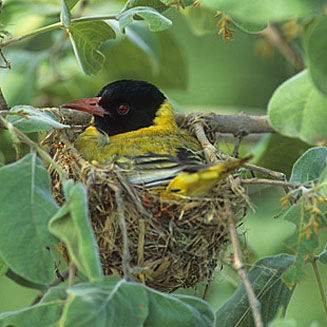|
Oriolus larvatus (Black-headed
oriole)
Swartkopwielewaal [Afrikaans]; Umkro, Umqokolo [Xhosa];
umBhicongo, umQoqongo [Zulu]; Nkulivere (generic term for oriole) [Kwangali];
Gotowa [Shona]; Phamahumu, Phamanyarhi [Tsonga]; Maskerwielewaal [Dutch]; Loriot
masqué [French]; Maskenpirol [German]; Papa-figos-de-cabeça-preta [Portuguese]
Life
> Eukaryotes >
Opisthokonta
> Metazoa (animals) >
Bilateria >
Deuterostomia > Chordata >
Craniata > Vertebrata (vertebrates) > Gnathostomata (jawed
vertebrates) > Teleostomi (teleost fish) > Osteichthyes (bony fish) > Class:
Sarcopterygii (lobe-finned
fish) > Stegocephalia (terrestrial
vertebrates) > Tetrapoda
(four-legged vertebrates) > Reptiliomorpha > Amniota >
Reptilia (reptiles) >
Romeriida > Diapsida > Archosauromorpha > Archosauria >
Dinosauria
(dinosaurs) > Saurischia > Theropoda (bipedal predatory dinosaurs) >
Coelurosauria > Maniraptora > Aves
(birds) >
Order: Passeriformes > Family: Oriolidae
The Black-headed oriole is common and widespread, occuring
throughout sub-Saharan Africa, from East Africa to southern Africa. It is quite
adaptable, occupying a variety of habitats, including savanna woodland, parks,
farmland and gardens. It eats a variety of invertebrates, fruit and seeds, often
foraging in mixed species flocks in the tree canopy. The nest is deep cup of
woven old-man's beard strands, moss and grass, place between stems of a fork in
a slender tree branch.
Distribution and habitat
Common in many areas of sub-Saharan Africa, from East
Africa to southern Africa. Here it occurs throughout Mozambique, Botswana,
Limpopo Province, KwaZulu-Natal and the Eastern Cape, with smaller populations
in extreme nothern Namibia, Western Cape and the North-west Province. It
is quite adaptable, occupying a variety of habitats, including Savanna woodland,
miombo (Brachystegiai) woodland, coastal forest, parks, gardens, farmland
with scattered trees and alien plantations.
|
 |
|
Distribution of Black-headed oriole in southern Africa,
based on statistical smoothing of the records from first SA Bird Atlas
Project (©
Animal Demography unit, University of
Cape Town; smoothing by Birgit Erni and Francesca Little). Colours range
from dark blue (most common) through to yellow (least common).
See here for the latest distribution
from the SABAP2. |
Predators
It has been recorded as prey of the following bird species:
Food
Eats a range of invertebrates, fruit and seeds, often
foraging in mixed species flocks in the tree canopy. The following food items
have been recorded in its diet:
- Invertebrates
- Apis mellifera (Honey-bee)
-
Lepidoptera (caterpillars)
- Bombycomorpha bifasciata (Barred eggarlet)
- Anadasia punctifascia (Chesnut eggarlet)
- Imbrasia belina (Mopane emperor moth)
-
Odonata (dragonflies and damselflies)
-
termite alates
- Plants
- Fruit
- Ficus (figs)
- Olea europaea (African olive)
- Coddia rudis (Small bone-apple)
- Nectar
- Erythrina latissima (Broad-leaved coral-tree)
- Greyvillea (alien Silky oak)
- Aloe
- Seeds of Brachychiton acerfolia (Australian flame tree)
Breeding
- The nest is a deep cup made of strands of old-man's beard lichen (Usnea),
moss, tendrils and grass woven together. It is usually placed between the
stems of a fork in a horizontal branch, often far from the main tree trunk,
usually 6-9 metres above ground.
 |
|
|
Black-headed oriole in its nest, Sericea
farm, South Africa. [photo Warwick Tarboton ©] |
|
- Egg-laying season is from September-February, peaking from
September-December.
- It lays 2-3 eggs, which are incubated for roughly 14-16 days.
- The chicks are fed a variety of food items, including bleached rings of
millipede exoskeletons, eventually leaving the nest after about 14-18 days.
Threats
Not threatened.
References
-
Hockey PAR, Dean WRJ and Ryan PG 2005. Roberts
- Birds of southern Africa, VIIth ed. The Trustees of the John Voelcker
Bird Book Fund, Cape Town.
|
